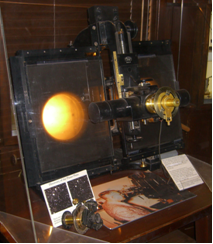- 1610: Galileo
- 1676: Ole Rømer
- 1687: Isaac Newton
- 1781: William Herschel
- 1838: Friedrich Bessel
- 1861: William and Margaret Huggins
- 1912: Henrietta Leavitt
- 1917 Einstein
- 1920: Harlow Shapley
- 1929 Edwin Hubble
- 1948: Ralph Alpher
- 1949: Fred Hoyle
- 1963: Maarten Schmidt
- 1964: Arno Penzias and Robert Wilson
- 1978: Vera Rubin and Kent Ford
- 1989: Margaret Geller and John Huchra
- 1992: John Mather and George Smoot
- 1995: Robert Williams
- 1998: Saul Perlmutter and Brian Schmidt
- 2010: Wendy Freedman
Blink Comparator
 |
| Blink comparator, Lowell Observatory. Image taken by Pretzelpaws. |
The Blink Comparator has been one of the most valuable instruments ever invented for the science of astronomy. Two photographic images of the same star field are placed on the left and right sides of the instrument. The observer looks through an eyepiece in the middle and lines up the two plates. The comparator then switches back and forth between the two plates, so that a star that is changing in brightness would be seen to rapidly flash on and off, while all the other stars remain the same. The instrument is also used to identify moving objects like planets, asteroids and comets. The instrument at right was used in the discovery of Pluto.